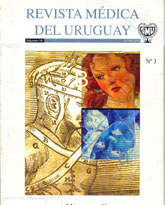Analysis of the geographic distribution of the population with cancer in Montevideo
Keywords:
NEOPLASMS, EPIDEMIOLOGICAL FACTORS, URUGUAYAbstract
To analyse pattern of geographic distribution of patients with any primary neoplasm in Montevideo, we examined data of cancer incidence for five years (1993-1997) provided by the National Cancer Record, Ministry of Health (Registro Nacional de Cáncer, Ministerio de Salud Pública, MSP).
Neighbourhoods were grouped according to geographic and lifestyle closeness, considering water supply and other services scarcity indexes. Five urban areas (coastal, central, eastern, northern and western) and three suburban areas were drawn.
Associations between variables were studied by means of descriptive and correspondence analysis. Results showed higher incidence of cancer in urban areas comparing to suburban areas.
The coastal and central areas were associated with high incidence of breast, prostate, colon and rectum cancer among people older than 65 years. Suburban areas showed lower incidence of any kind of cancer. Further studies need to be done to detect environmental and lifestyle factors associated with cancer.
References
2) Parkin D, Whelan J, Ferlay J, Aymond L, Young J. "Cancer incidence in five continents". Lyon: International Agency for Research on Cancer, 1997 (Nº 143).
3) Vasallo J, Barrios E. II Atlas de mortalidad por cáncer en el Uruguay. Comparación de dos quinquenios: 1989-1993 y 1994-1998. Montevideo: Comisión Honoraria de Lucha contra el Cáncer, 1999: 180-279.
4) Ronco A, De Stéfani E. Distribución geográfica de los tumores del aparato digestivo en Montevideo. II Congreso Uruguayo de Oncología. Arch Med Inter Uruguay (Montevideo) 1994; (Nº especial): 14: 41.
5) Ronco A, De Stéfani E. Patrones de distribución zonal de los principales tumores digestivos en Montevideo. V Congreso Latinoamericano de Oncología. Arch Med Inter Uruguay (Montevideo) 1996; (Nº especial): 16: 41.
6) Ronco A, De Stéfani E. Epidemiología del cáncer de pulmón en el Uruguay. Premio Nacional de Neumología 1995. Montevideo: Academia Nacional de Medicina del Uruguay. 1996: 16-18.
7) Birks HJB, Peglar SM, Austin HA. An Annotated Bibliography of Canonical Correspondence Analysis and Related Constrained Ordination Methods 1986-1993, Bergen, Allégaten 41, N 5007, Bergen, Norway. Botanical Institute, University of Bergen, 1994, versión en hipertexto: http://www.microcomputerpower.com/ccabib (consultada julio 2001).
8) Statistic Program for Social Sciences versión 10.0 para Windows. Michigan: SPSS Inc, 1999.
9) Canoco JF. Versión 4.0 para Windows. CPRO-DLO Box 100, 6700AC Wageninen: Centre for Biometry Wageningen, 1998.
10) Vasallo J, De Stéfani E, Ronco A, Barrios E. Urbanization gradients and cancer mortality in Uruguay. Int J Cancer 1994; 59(3): 345-50.
11) Steenland K, Boffetta P. Lead and cancer in humans: where are we now? Am J Int Med 2000; 38(3): 295-9.
12) Cocco P, Dosemeci M, Heineman E. Brain cancer and occupational exposure to lead. J Occup Environ Med 1998; 40(11): 937-42.
13) Langford I, Bentham G, Mc. Donald A. Multi-level modelling of geographically aggregated health data: a case study on malignant melanoma mortality and UV exposure in the European community. Stat Med 1998; 171(1): 41-57.
14) Rican S, Salem G, Jougla E. Spatial variation of lung cancer death in France and spatial scales: Importance of changing scale in health geography. Revue d’Epidemiologie et de Sante Publique 1999; 45(5): 411-20.
15) Hills M. Some comments on methods for investigating disease risk around a point source. In: Elliot P, Cuzick J, English D, Stern R. "Geographical and environmental epidemiology. Methods for small-area studies". Oxford: Oxford University, 1991.
16) Wittie P, Drane W, Aldrich T. Classification methods for de-nominators in small areas. Stat Med 1996; 15(17-18): 1921-6.
17) Gatrell A, Bailey T. Interactive spatial data analysis in medical geography. Social Science Med 1996; 42(6): 843-55.
18) Wakefield J, Elliot P. Issues in the analysis of small area health data. Stat Med 1999; 18(17-18): 2377-99.
19) Ward M, Nuckols J, Weigel S, Maxwell S, Cantor K, Mieller R. Identifying populations exposed to agricultural pesticides using remote sensing and a geographical information system. Enviromental-Health Perspectives 2000 108(1): 5-12.












